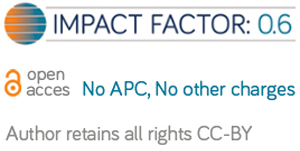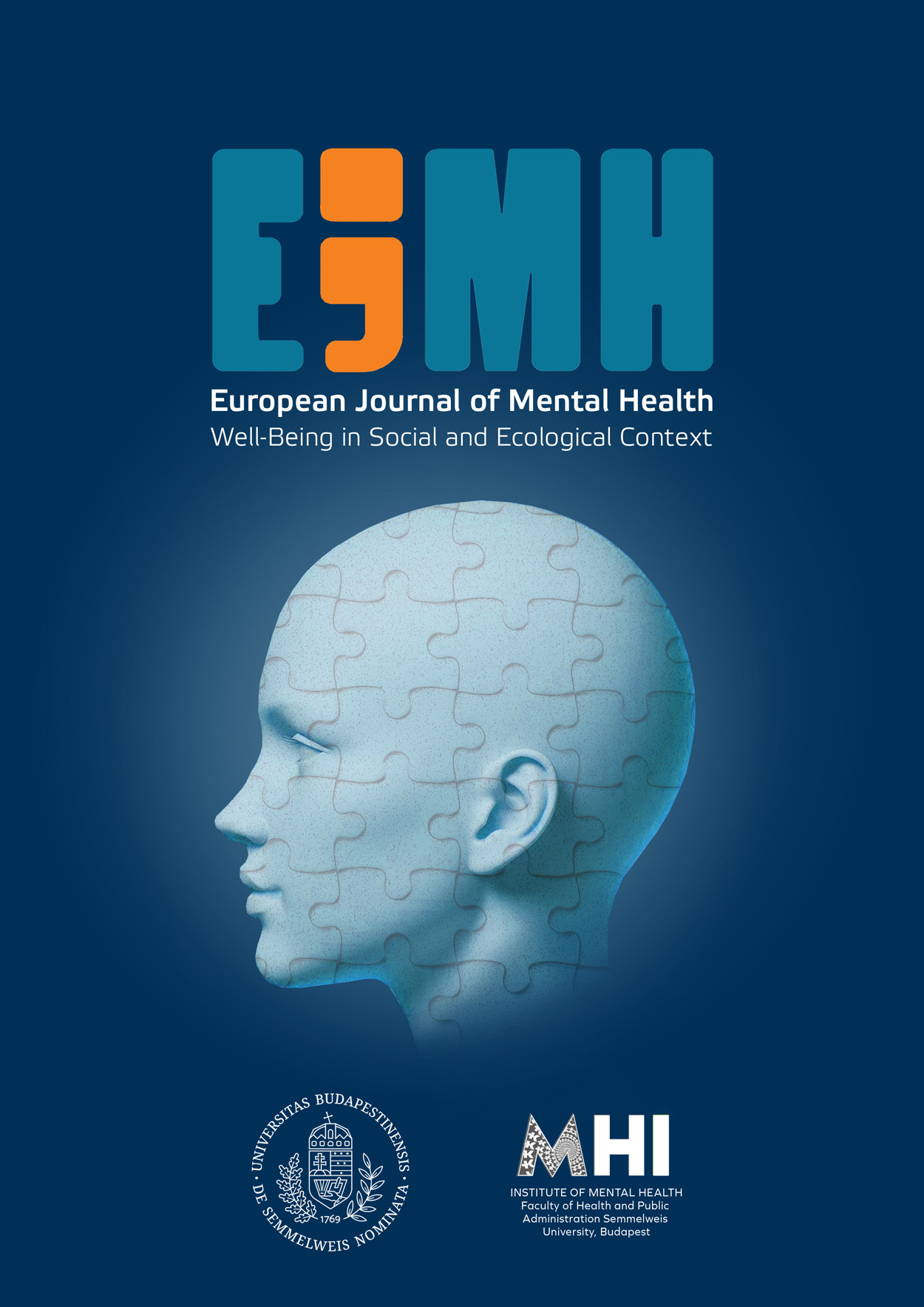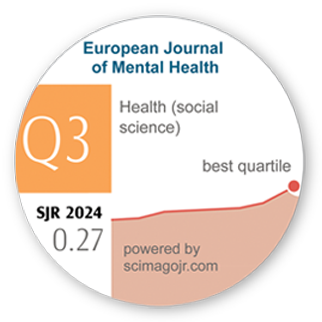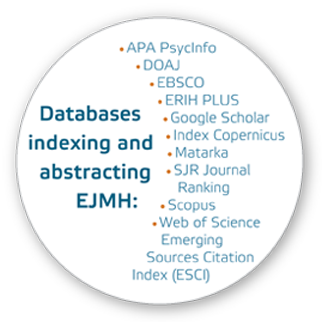Factor Structure and Internal Consistency Reliability of the Croatian Version of the Family Adaptability and Cohesion Evaluation Scale (FACES) IV Package: A Preliminary Study
DOI:
https://doi.org/10.5708/EJMH.19.2024.0029Keywords:
confirmatory factor analysis (CFA), exploratory factor analysis (EFA), family functioning, FACES IV Package, family satisfactionAbstract
Introduction: A family operates as a dynamic system comprising various subsystems and is continually interacting with its environment. Therefore, it is essential to comprehend the underlying principles of family functioning. One of the most commonly used models for describing family functioning is the Circumplex Model of Marital and Family Systems (Olson & Gorall, 2003).
Aims: In this study, we aimed at examining the factor structure and internal consistency reliability in the Croatian version of the Family Adaptability and Cohesion Evaluation Scale IV Package, which measures family functioning through family cohesion and flexibility at the balanced and unbalanced levels, as well as family communication and family satisfaction.
Methods: Confirmatory factor analysis (CFA) and exploratory factor analysis (EFA) were performed using a convenient sample of 528 participants.
Results: CFA revealed that the Croatian version of the FACES IV Package does not fit the theoretical model of the original factor structure in this preliminary study. The exceptions were the Family Communication Scale and Family Satisfaction Scale, which showed satisfactory parameters. The results of the EFA of FACES IV showed a 5-factor model solution.
Conclusions: The Croatian version of the FACES IV Package is not completely suitable for use in the national context. Thus, given these preliminary findings, further testing on a more representative or clinical sample is recommended.
References
Alić, A. (2016). Razumijevanje obiteljske dinamike posredstvom transgeneracijskog i strukturalnog modela [Understanding family dynamics through a transgenerational and structural model]. In A. Pašalić Kreso (Ed.), Zbornik radova Odsjeka za pedagogiju, “Ka novim iskoracima u odgoju i obrazovanju” [Proceedings of the Department of Pedagogy, “Towards new steps in education”] (pp. 152–163). Faculty of Philosophy at the University of Sarajevo.
Baiocco, R., Cacioppo, M., Laghi, F., & Tafa, M. (2013). Factorial and construct validity of FACES IV among Italian adolescents. Journal of Child and Family Studies 22, 962–970.
https://doi.org/10.1007/s10826-012-9658-1
Bandura, A., Caprara, G. V., Barbaranelli, C., Regalia, C., & Scabini, E. (2011). Impact of family efficacy beliefs on quality of family functioning and satisfaction with family life. Applied Psychology, 60(3), 421–448.
https://doi.org/10.1111/j.1464-0597.2010.00442.x
Bentler, P. (1990). Comparative fit indexes in structural models. Psychological Bulletin, 107(2), 238 – 246.
https://escholarship.org/uc/item/2mk8r49v
Comrey, A. L., & Lee, H. B. (2013). A first course in factor analysis (2nd ed.). Psychology Press.
https://doi.org/10.4324/9781315827506
Everri, M., Caricati, L., Mancini, T., Messena, M. & Fruggeri, L. (2020). Italian Validation of Family Adaptability and Cohesion Scale (FACES IV) Short Version for Adolescents: SAD_FACES. Journal of Child and Family Studies, 29, 2507–2514.
https://doi.org/10.1007/s10826-020-01771-9
Gomes, H. M. S., Peixoto, F., & Gouveia-Pereira, M. (2017). Portuguese validation of the family adaptability and cohesion evaluation scale – FACES IV. Journal of Family Studies, 25(4), 477–494.
https://doi.org/10.1080/13229400.2017.1386121
Gouveia-Pereira, M., Gomes, H., Miranda, M., & Candeias, M. J. (2020). Coesão e flexibilidade familiar: Validação do pacote FACES IV junto de adolescentes portugueses. [Family training and flexibility: Validation of the FACES IV package with Portuguese adolescents]. Análise Psicológica [Psychological Analysis], 38(1), 111–126.
https://doi.org/10.14417/ap.1651
Hamilton, E., & Carr, A. (2016). Systematic review of self-report family assessment measures. Family Process, 55(1), 16–30.
https://doi.org/10.1111/famp.12200
Hu, L-t., & Bentler, P. M. (1999). Cutoff criteria for fit indexes in covariance structure analysis: Conventional criteria versus new alternatives. Structural Equation Modeling: A Multidisciplinary Journal, 6(1), 1–55.
https://doi.org/10.1080/10705519909540118
Jokić, B., & Ristić Dedić, Z. (2023). Obiteljski odnosi u Republici Hrvatskoj iz perspektive mladih: Rezultati povodom međunarodnog dana obitelji [Family relations in the Republic of Croatia from the perspective of young people: Results on the occasion of International Family Day] [Poster presentation]. International Family Day.
https://tinyurl.com/3fk8xyff
Kaiser, H. F. (1974). An index of factorial simplicity. Psychometrika, 39, 31–36.
https://doi.org/10.1007/BF02291575
Kalkbrenner, M. T. (2021). A practical guide to instrument development and score validation in the social sciences: The MEASURE approach. Practical Assessment, Research, and Evaluation, 26(1), 1–18.
https://doi.org/10.7275/svg4-e671
Koutra, K., Triliva, S., Roumeliotaki, T., Lionis, C., & Vgontzas, A. N. (2013). Cross-cultural adaptation and validation of the Greek version of the Family Adaptability and Cohesion Evaluation Scales IV Package (FACES IV Package). Journal of Family Issues, 34(12), 1647–1672.
https://doi.org/10.1177/0192513X12462818
Lee, M. S. (2014). Consideration of the appropriateness of Korean FACES IV focused on the process of translating a scale. Korean Journal of Physical Multiple & Health Disabilities, 57(2), 23–44.
https://doi.org/10.20971/kcpmd.2014.57.2.23
Ljubetić, M., Reić Ercegovac, I., & Mandarić Vukušić, A. (2020). Percepcija obiteljske komunikacije adolescenata i njihovih roditelja – Rezultati preliminarnog istraživanja modela [Perception of family communication of adolescents and their parents – Results of preliminary model research]. Nova Prisutnost: Časopis za Intelektualna i Duhovna Pitanja [New Presence: Journal of Intellectual and Spiritual Issues], 18(2), 279–292.
https://doi.org/10.31192/np.18.2.4
Mirnics, Z., Vargha, A., Tóth, M., & Bagdy, E. (2010). Cross-cultural applicability of FACES IV. Journal of Family Psychotherapy, 21(1), 17–33.
https://doi.org/10.1080/08975351003618577
Nacionalno etičko povjerenstvo za istraživanje s djecom [National Ethics Committee for Research with Children]. (2020). Etički kodeks istraživanja s djecom [Ethical Code for Research with Children].
https://mrosp.gov.hr/istaknute-teme/obitelj-i-socijalna-politika/obitelj-12037/djeca-i-obitelj-12048/nacionalno-eticko-povjerenstvo-za-istrazivanje-s-djecom/12191
Olson, D. H. (2000). Circumplex model of marital and family systems. Journal of Family Therapy, 22(2), 144–167.
https://doi.org/10.1111/1467-6427.00144
Olson, D. H. (2010). Family Satisfaction Scale. Life Innovations.
Olson, D. (2011). FACES IV and the Circumplex Model: Validation study. Journal of Marital and Family Therapy, 37(1), 64–80.
https://doi.org/10.1111/j.1752-0606.2009.00175.x
Olson, D., & Gorall, D. M. (2003). Circumplex model of marital and family systems. In F. Walsh (Ed.), Normal family processes: Growing diversity and complexity (3rd ed., pp. 514–548). The Guilford Press.
Olson, D., Gorall, D. M., & Tiesel, J. (2006). Faces IV and the Circumplex Model. Life Innovations.
Olson, D. H., Sprenkle, D. H., & Russell, C. S. (1979). Circumplex model of marital and family systems: I. Cohesion and adaptability dimensions, family types, and clinical applications. Family Process, 18(1), 3–28.
https://doi.org/10.1111/j.1545‑5300.1979.00003.x
Rada, C. (2018). Latent class analysis approach for the Family Adaptability and Cohesion Evaluation Scale IV among young people from Romania: The first step for validation. Journal of Family Issues, 39(6), 1598–1615.
https://doi.org/10.1177/0192513X17714508
Rivero, N., Martínez-Pampliega, A., & Olson, D. H. (2010). Spanish adaptation of the FACES IV questionnaire: Psychometric characteristics. The Family Journal, 18(3), 288–296.
https://doi.org/10.1177/1066480710372084
Sanderson, J., Kosutic, I., Garcia, M., Melendez, T., Donoghue, J., Perumbilly, S., Franzen, C. & Anderson, S. (2009). The measurement of outcome variables in couple and family therapy research. American Journal of Family Therapy, 37(3), 239–257.
https://doi.org/10.1080/01926180802405935
Schumacker, R. E., & Lomax, R. G. (2016). A beginner’s guide to structural equation modeling (4th ed.). Routledge.
Sequeira, J., Vicente, H. T., Daniel, F., Cerveira, C., Silva, M. I., Neves, S., Espírito Santo, H., & Guadalupe, S. (2021). Family Adaptability and Cohesion Evaluation Scale–Version IV (FACES IV): Validation study in the Portuguese population. Journal of Child and Family Studies, 30, 1650–1663.
https://doi.org/10.1007/s10826-021-01941-3
Siswaningsih, W., Firman, H., & Khoirunnisa, A. (2017). Development of two-tier diagnostic test pictorial-based for identifying high school students misconceptions on the mole concept. Journal of Physics: Conference Series, 812, Article 012117.
https://doi.org/10.1088/1742-6596/812/1/012117
Steiger, J. H. (2007). Understanding the limitations of global fit assessment in structural equation modeling. Personality and Individual Differences, 42(5), 893 – 898.
https://doi.org/10.1016/j.paid.2006.09.017
Tomić-Koludrović, I., & Petrić, M. (2007). Hrvatsko društvo-prije i tijekom tranzicije [Croatian society-Before and during the transition]. Društvena istraživanja [Social Research], 16(4–5), 867–889.
Vegas, M. I., Mateos-Agut, M., Pineda-Otaola, P. J., & Sebastián-Vega, C. (2022). Psychometric properties of the FACES IV package for Spanish adolescents. Psicologia: Reflexão e Crítica, 35, Article 18.
https://doi.org/10.1186/s41155-022-00222-2
Watkins, M. W. (2018). Exploratory factor analysis: A guide to best practice. Journal of Black Psychology, 44(3), 219–246.
https://doi.org/10.1177/0095798418771807






